Realizing the sustainable development goals by 2030 will require a paradigm shift in the ways governments respond to ever-increasing developmental challenges. It will require rethinking the role of government in the digital age, and the way it interacts with society and the private sector. How can governments in the digital era manage the public affairs of a country, respond to the needs of its people, deliver services and manage its development and economy sustainably. Digital government approaches have the potential to accelerate achieving the sustainable development goals and ensuring that no one is left behind. In the 2018 edition of its influential survey of digital government progress worldwide, the United Nations Department of Economic and Social Affairs revealed emerging global trends as well as new challenges in the digital age. How should governments take advantage of these emerging digital government opportunities to accelerate the implementation of the sustainable development goals?
Digital Government and Sustainable Development
Since 2001, the United Nations Department of Economic and Social Affairs of United Nations (UNDESA) has published the UN E-Government Survey, the only publication worldwide providing a status of national e-government performance for all 193 Member States of United Nations. The Survey is mainly intended for policy makers, government officials, academia, civil society, private sector and other practitioners and experts in the areas of public administration, e-government, and ICTs for development. It serves as a development and benchmarking tool for countries to learn from each other, identify areas of strength and challenges in e-government and shape their policies and strategies in this area. It also informs on issues related to digital transformation and cooperation and to the critical role of ICT and new technologies in achieving sustainable development.
Technologies, particularly ICT, are intrinsically linked to the development of today’s societies and play an important role to the successful achievement of the 2030 Agenda for Sustainable Development and for the implementation of its 17 Sustainable Development Goals (SDGs).
In September 2015, all the world leaders have adopted an ambitious people-and planet-centred agenda, aiming to "achieve prosperity and peace, for the planet and for all peoples, through partnerships at all levels".
Since then, we have been observing progresses and tractions, but also sensing urgent and pressing actions to be taken to fulfil the universal principles of inclusiveness, justice, equality and sustainable development embedded in the agenda.
Governments, together with the private sector and civil society, will play a central role in the implementation of the SDGs. They will need to drive the principles and goals of the agenda throughout public institutions at local, national, regional and international levels. This means in particular ensuring that the overarching objective of poverty eradication and "leaving no one behind" guides all institutions, actors and policies and public service delivery. Digital government is now considered a powerful development tool capable of applying the above principles to all, and enabling the achievement of the SDGs.
Reaching these goals in all countries and creating peaceful, just and inclusive societies will be extremely difficult in the absence of effective, accountable and inclusive institutions. Institutions need to be capable and equipped to adapt the Agenda to the national situation, mobilizing their societies and the private sectors in implementing the SDGs. Capacities and innovation on all levels, but especially in ICT and e-government, will be required to promote policy integration, enhance public accountability, promote participation for more inclusive societies as well as ensure equitable and effective public services for all, particularly for the poorest and most vulnerable groups.
There are many and complex opportunities for deploying e-government to build resilient societies. Basic services such as transportation, health, education, water and sanitation, as well as sound infrastructure and utilities, are essential to sustaining development and improving quality of life. But in order to be truly effective, these services must be made available to everyone.
New and existing technologies are essential for broader access as well as the provision of significant benefits to service users at a reduced cost. It is therefore important to rethink how to provide universal access to quality services while ensuring coherent decisions, developing integrated policies and increasing effectiveness, transparency and accountability. It will also require far-sighted and holistic decision-making and an unprecedented level of policy integration and institutional coordination.
Sustainable, effective and inclusive service delivery will only be achieved if all the stakeholders take an integrated and balanced approach to social, economic and environmental dimensions – as well as to the various SDGs areas. Governments should accept that, although the public sector is normally the biggest and most powerful actor, it does not have a monopoly on resources or the full ability to innovate. Governments need to retain overall responsibility for quality, standards, and ethics, and ensure that no one is left behind but should also act as enabler and driver in supporting the increased capacities of other state actors—as well as civil society and the commercial sector—to participate alongside the public sector in addressing digital transformation.
The Paradox of Digitized Government
Digital government progress is creating numerous opportunities. At the same time, increased digitization in itself creating emerging risks. This paradox is exemplified in the following example.
With an average of 24 million people pushed into poverty every year by natural and man-made disasters, it is essential to strengthen resilience for sustainable progress to ensure that people, societies, and institutions have the resources, capacities and knowledge to limit, anticipate, absorb and adapt to shocks.
By using digital technology, governments can—and are—responding to shocks emanating from the above mentioned disasters and various types of other crises, manage emergency responses, perform essential functions, and swiftly recover from crises.
In addition to post-disaster studies and technical solutions, policy plays a pivotal role in disaster risk management. Based on the Sendai Framework for Disaster Risk Reduction 2015-2030, government focus should be shifted from responding to disasters to anticipating them in order to reduce and manage their disaster risk. This can be done through the use of data and ICTs, which are vital to identifying, managing and mitigating risk before a disaster strikes. Indeed, like public policy, ICTs are an essential element in disaster risk management, as during disasters, and in cooperation with geospatial technology and space applications, these technologies can be instrumental in providing swift response and ensuring emergency communication services. ICTs can also support the operation of national critical infrastructures, and can ensure continuous and critical communication and service delivery across all phases of disaster management.
However, ICTs themselves and e-government ecosystems are critical infrastructures to be protected from disasters. Management of ICT-driven approaches must be improved for the sake of continuity of online services as well as to protect critical financial and industrial information, in addition to people’s data and privacy.
The growing rate of cybersecurity attacks is a vivid example of how internet capacities are being used, not only for the benefit or empowerment of societies, but also to "degrade and enslave". Technology is the first line of defence against cyber threats and malicious online agents. Without adequate technical measures and the capabilities to detect and respond to cyberattacks, e-government systems and their respective entities are vulnerable.
But rapid technological developments and globalization have brought new challenges for the protection of sensitive information and personal data. Governments and international organizations may not be prepared for rapid developments in the cyber environment, and existing regulations on how to address cybercrime may no longer be applicable. This requires a decidedly stronger and more coherent framework of protection at national and international levels, backed by effective enforcement.
The Internet is a highly interdependent system, and no single actor can adopt a fix-all solution to overcome threats that arise from its use. A secure e-government system requires collaboration among all stakeholders including vendors, industries, manufacturers, academia, government and civil society. Therefore, cooperation among relevant stakeholders such as central governments, local public authorities, the private sector, academia, civil society and international organizations, are crucial.
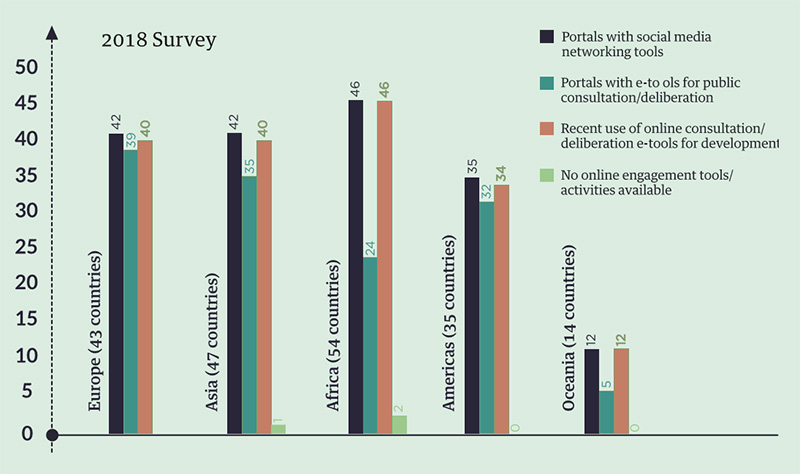
Number of countries with online engagement tools on national portals and their Usage – Source: The UN E-Government Survey, UNDESA
Global and Regional Trends in Digital Government: Two Decades Later
Internet use has proliferated since its inception. By 2017, it was estimated that 3.7 billion people, approximately half of the world’s population, have access to and continuously use the internet. With big data, machine learning, and the Internet of Things, some experts anticipate that the number of Internet connections may grow to nearly a trillion by 2035.
Similarly, there has been an ever-increasing amount of government services that are conducted online. Digital government has grown rapidly over the past 17 years, since the first attempt of the United Nations to benchmark e-government in 2001.
Countries in all regions are increasingly embracing innovation and utilizing ICTs to deliver services and engage people in decision-making processes, with e-government development by Member States progressing with the use of the latest tools and internet technologies. These technologies have provided advanced tools and resources for governments to deliver public services, engage citizens in policy making, improve transparency and monitor development plans.
One of the most important new trends is the advancement of people-driven services. It addresses the growing demand for more personalized services that reflect individual needs, as well as people’s aspiration to be more closely engaged in the design and delivery of services. These new demands are transforming the way the public sector operates. At the same time, disparities remain within and among countries.
In general, the 2018 survey has revealed a positive upward trend in the UN E-Government Development Index (EGDI), with 40 countries scoring very high, a rise from 29 countries two years prior. The margin at the bottom has also shown a decrease, with low-EGDI levels dropping a significant 50 percent in the same two-year period.
Among the top 10 countries, Denmark and Australia take first and second place, while Australia leads the chart in human capital development and is in the top 10 in online services. The Republic of Korea also remains in the third spot, performing well in online service and technology infrastructure, but its human capital development was relatively low compared to other top ranked countries. At a glance, the regional EGDI averages in 2018 mirror those of previous Surveys in which Europe continues to lead with the highest regional EGDI, followed by the Americas, Asia, Oceania and finally Africa.
Examining previous trends, there has been no change in regions’ positions since 2003, for a variety of possible reasons. The use of digital technologies may create new opportunities for developing countries to bridge the digital divide. However, developed countries with existing technological infrastructure are primed to experience the benefits of such innovations, potentially leaving many other countries behind, adding another dimension to the already widening digital divide.
Global efforts to bridge access to the internet are improving. At the same time, there are large regional differences. In Europe, almost 80 per cent of the population used the internet. The Commonwealth of Independent States and the Americas followed as the only regions where more people use the internet than do not. In Africa, only 22 per cent were estimated to use the Internet in 2017, leaving the continent lagging all other regions.
If we look at the African Region for example, only 4 countries out of 54 score higher than the world average. Africa has large gaps in infrastructure, including broadband infrastructure and access to broadband services, where it exists, is very expensive. This is evident in the region’s low Telecommunication Infrastructure Index (TII), and progress with respect to the EGDI across the whole region remains positive albeit uneven.
The Americas, meanwhile, show continued improvement in e-government development into 2018. The region is no longer represented in the low-EGDI and low-OSI levels. Uruguay has moved from a High-EGDI to a Very-High-EGDI level country in 2018, followed closely by Chile and Argentina just below the Very-High-EGDI threshold. Since 2016, eight countries (Panama, Antigua and Barbuda, Dominica, Dominican Republic, El Salvador, Bolivia, Saint Vincent and the Grenadines and Paraguay) have improved their EGDI level from Medium to High-range. These positive developments have allowed the Americas to maintain its position as the second most developed region in e-government development, worldwide. The top performing country in the Americas region remains the United States, one of the world leaders in e-government.
Asia poses some unique challenges, as it is not only the most populous region, but it is also the largest continent in terms of land mass. The e-government development trend is therefore highly diverse across the countries in the region. The Republic of Korea (third), Singapore (seventh) and Japan (tenth) are ranked among the top 10 in the world, while in the low-EGDI spectrum are the Democratic People’s Republic of Korea (185th) and Yemen (186th). Such vast differences in the availability of e-government services depicting high levels of dispersion across the region. Despite this, Asia’s strong performance in e-government development from 2016 to 2018 is a continuing challenge to the America’s position as the second best performing region.
Within the Arab region, the Gulf Cooperation Council (GCC) have made some important strides in e-government, as the United Arab Emirates has the highest EGDI among GCC countries followed by Bahrain, Kuwait and Qatar. GCC countries managed to achieve a series of substantial accomplishments related to improving e-government systems and making it easier for citizens to access government portals of other GCC Member States.
Scores and rankings of Arab states in the UN E-Government Survey 2018 – Source: The UN E-Government Survey, UNDESA
Oceania consists of two developed countries, Australia and New Zealand, juxtaposed within the region, with island-states having smaller populations, economies and, by extension, fewer resources. Australia and New Zealand, in the top 10 countries with very high levels of EGDI, presents this stark contrast vividly. Fiji and Tonga, the 3rd and 4th ranking countries within the region, are outside of the top 100 ranked countries, despite having relatively high EGDI scores.
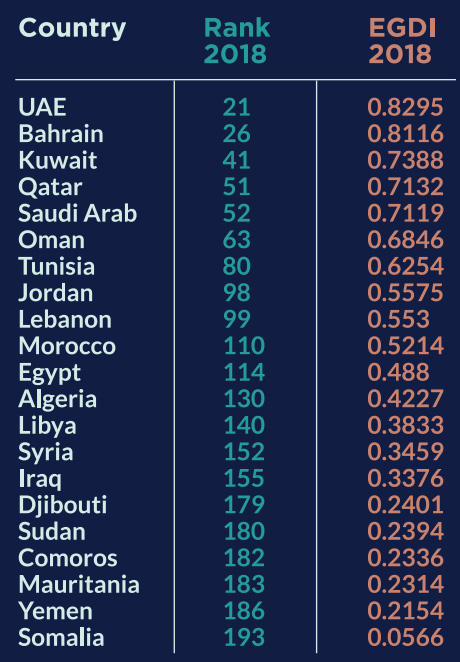
Scores and rankings of Arab states in the UN E-Government Survey 2018 – Source: The UN E-Government Survey, UNDESA
Leaving No One Behind: Bridging the Digital Divide
Despite this progress, disparities remain within and among countries. Even with the technological advances in e-government, an increasingly digitized world carries risks, including growing threats to social cohesion and economic prosperity, as well as planetary challenges related to bridging the digital divide.
Digital divides are no longer considered to be only a lack of access to ICT infrastructure, neither are they necessarily a division between high and low-income countries. Given the progress of e-government, digital divides exist in all countries, and they must be bridged to enable everyone to take full advantage of what the digital society is offering.
A lack of e-inclusion could put vulnerable populations at risk of falling further behind, as the international survey shows a negative correlation between digital use and social exclusion. Online use offers an opportunity for e-inclusion but also risks a new digital divide, owing to insufficient access in low-income countries, either because of a lack of devices or of bandwidth and speed.
It is true that the greater ease with which information is gathered, stored, analysed and disseminated, and the decreasing cost and coverage of mobile-cellular and mobile broadband subscriptions, have both improved e-service delivery to vulnerable populations. However, it is also true that the majority of the world’s population remains offline, which increases the risk that vulnerable groups without internet access will fall further behind in the rapidly progressing digital society. Thus, technology can both aid and impede the overarching goal of leaving no one behind.
There are many opportunities to enhance social and digital inclusion through e-government and emerging technologies. Innovative multi-stakeholder partnerships can help to expand e-government access for all and provide dedicated services to address traditional problems related to poverty and social exclusion.
There has been notable progress recently in e-services aimed at disadvantaged groups, including among persons with disabilities, older persons, women, youth, indigenous peoples, people living in poverty, and other vulnerable groups. The number of country websites with information about specific programmes and initiatives to benefit these groups and communities has been increasing steadily since 2012.
Great emphasis is being placed on mobile government services in delivering remote education, health and other social services, which impact positively on people’s everyday lives. Meanwhile, cutting-edge technologies such as artificial intelligence (AI) is also improving the efficiency of service delivery to marginalized groups. These are some of the developments taking place in efforts to bridge the digital divide.
Fast-Evolving Technologies in Digital Government: Opportunities and Concerns
Today, fast-evolving technologies have the potential to transform the traditional ways of doing things across all functions and domains of government as well as the ways in which ICTs offer governments an unprecedented opportunity to achieve sustainable development and improve the well-being of their citizens.
Governments, in close collaboration with the private sector and academia, are studying fast evolving technologies and how the results and the outcomes of the implementation of these technologies such as Big Data, artificial intelligence or deep machine learning could be used and adapted for service delivery in public administration. In the Arab region, for example, the United Arab Emirates is on a path to make the country a leader in AI. In October 2017, the country created a strategy for AI and appointed the world’s first Minister of State for AI.
The use of these frontier technologies may create new opportunities for development and economic growth in almost every aspect of government like health care, law enforcement, food security, crisis mitigation, and others; governments can utilize the advantages offered by AI in providing a wide array of services but which at the same time are tailored to the specific needs of each citizen at a 24/7 basis.
These services designed with information gleaned from big data as well as those obtained through improved citizen engagement can dramatically improve the interaction between government and its citizens. The 4th industrial revolution has the potential to change our societies and enhance our ways of life and at, as they say, a fast and furious pace.
On the other hand, it comes with big challenges. As stated by the UN Under Secretary for Economic and Social Affairs, Mr. Liu Zhenmin, "there is a need to consider the unprecedented challenges introduced by new frontier technologies. Without careful planning and design, for example, artificial intelligence has the potential to harm vulnerable populations, reinforce existing inequalities, widen digital divides and adversely affect jobs and economies."
It is essential that governments and those in the public sector are able to ride the wave of this trend by being prepared with adaptive policies and regulations and sufficient support for its citizenry to be re-skilled and to adapt to collaborating with machines at work.
Some jobs will inevitably be lost, but new ones with new tasks and even newer skills will be demanded in this new frontier. A new code of ethics will need to be observed by everyone to ensure that these technologies work to enhance our way of life and not create deeper inequality among peoples and countries.
New technologies such AI are already indispensable and universal resources for the humanity but must be equally distributed within and among countries and be available for everyone or every government, no matter its own level of development or capacity.
Approaching Development through Digital Government: A Guiding Principle
Through the resolution adopted by the United Nations General Assembly last year, all Member States recognizes that the pace and scope of rapid technological change can have far-reaching implications—both positive and negative—for the achievement of sustainable development, requiring international and multi-stakeholder cooperation to benefit from opportunities and address challenges. If there is one lesson to be extracted from two decades of digital government progress globally, it is that digital transformation will not only depend on digital technologies, but also on principles such as effectiveness, inclusiveness, accountability, trustworthy and openness which should direct the use of digital technologies and not the other way around.
Vincenzo Aquaro is the Chief of the Digital Government Branch of the Division for Public Institutions and Digital Government of the United Nations Department of Economic and Social Affairs. Read full bio here.
End Notes:
1. This article and its policy recommendations are based on the findings of the 2018 UN e-Government Survey by the UN DESA. It is prepared by Vincenzo Aquaro, Chief of Digital Government Branch, Division of Public Institutions and Digital government, UNDESA. Chief editor and coordinator of the UN 2018 E-Government Survey – Disclaimer: The views and opinions expressed in this article are those of the author in his own professional capacity and do not necessarily reflect the official policy or position of any agency or body of United Nations. Examples of analysis performed within this article are only examples and are based only on very limited published open source information. Assumptions made within the analysis are not necessarily reflective of the official position of any Agency or Body of United Nations.
2. As for the Secretary-General’s Message for International Day for Disaster Reduction,13 October 2017 available at: https://www.un.org/sustainabledevelopment/blog/2017/10/secretary-generals-message-for-international-day-for-disaster-reduction/
3. The outcome document of the World Summit on Disaster Risk Reduction, Sendai, Japan 2015




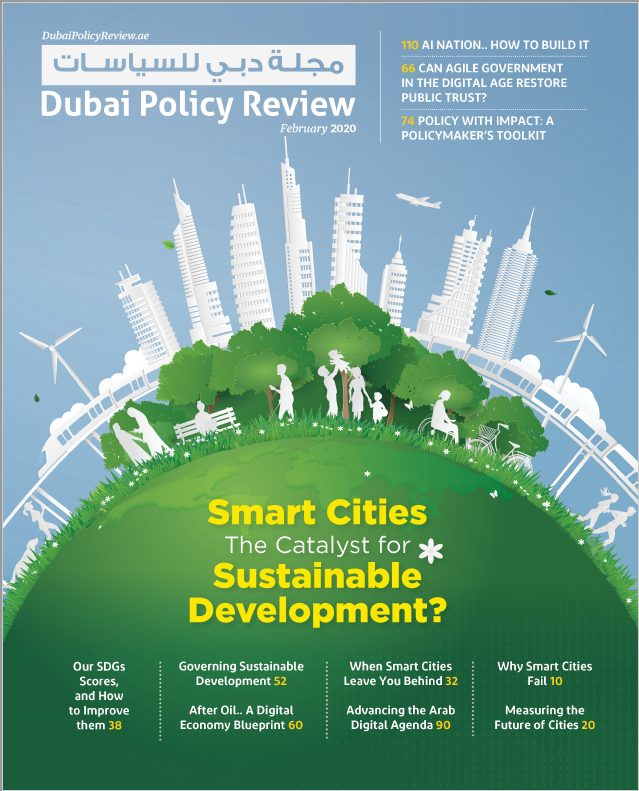


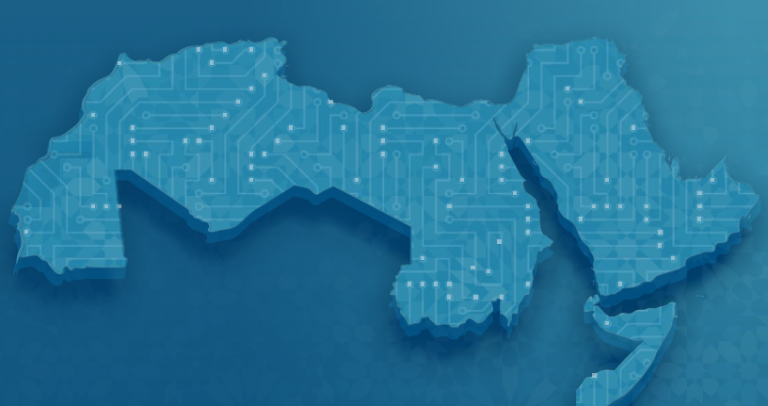





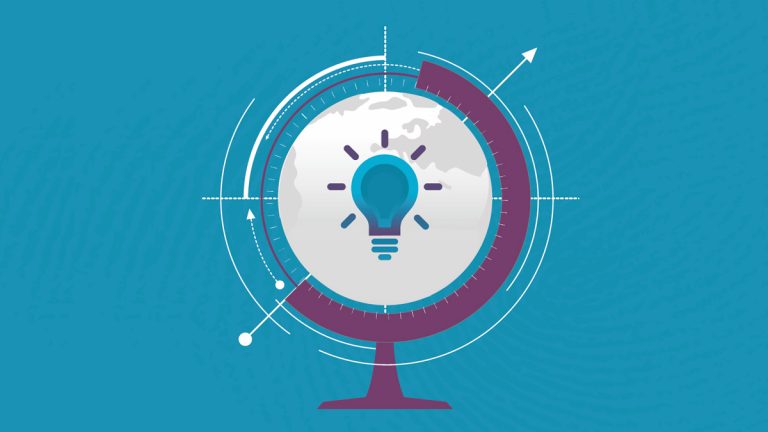

You must be logged in to post a comment.